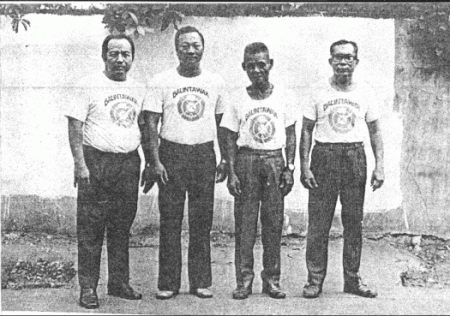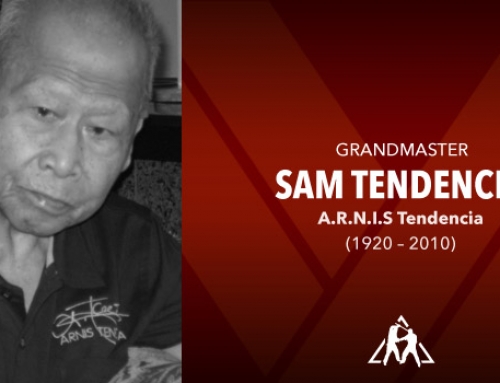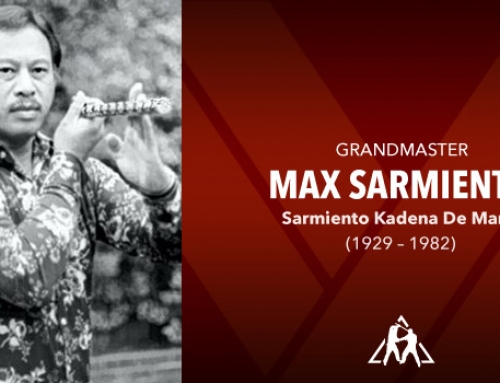Balintawak Arnis/Escrima: ‘Venancio Bacon’ or ‘Tatay Anciong’ as he was known by his Filipino nickname, was the first to call his school/club Balintawak.
To begin with, one of the first major Escrima schools in Cebu was the ‘Labangon Fencing Club’ of the 1920’s. The Saavedra family, especially Lorenzo Saavedra and his nephews Teodoro and Frederico Saavedra and the older brothers were the main influence and force behind it. Venancio Bacon was one of the Saavedra’s students and was also a close family friend.
In World War Two the Saavedra family was all but wiped out by the Japanese. After the war the Escrima school was far from the remaining Saavedra family members minds.
Anciong Bacon, one of the instructors of the old school of the Saavedra’s, decided to open his own club. Bacon maintained and taught the old and pure style as he was taught. He opened his first gym in Balintawak street in Cebu City in 1951.
The term ‘Balintawak’ refers to an area in Luzon where in 1896 a successful revolt and battle took place against the Spanish. Balintawak was later used by other Filipinos during different battles as a war cry, so Venancio thought it fitting that his new club should be named after the street where his club was located and the patriotic symbol and battle cry of the warriors of his country.
Venancio was expert in several styles of Escrima, and was also skilled in Boxing, Filipino grappling or ‘Dumog’ and Jui Jitsu, which is referred to by some Filipinos as ‘Combat Judo’.
He reasoned that by combining the theories and concepts of these different styles of fighting a very rough and effective form of Martial Art could be produced. His style of teaching however was quite different from the way some Balintawak schools teach today. Anciong’s style had no clear lines of instruction, his students were taught techniques and fighting principles at random.
One of Tatay “Anciong” successors to Balintawak was his closest friend, a Lawyer called ‘Attorney Jose Villasin’. Tatay “Anciong” thought Attorney Villasin all the techniques from the advance lessons of arnis down to a hand-to-hand combat fighting in a secret meeting session and trained him without the knowledge of everybody.
On one other occasion Delfin Lopez invited Attorney Villasin to be as a dummy in a show attended by a small gathering of audience. In the middle of the clicking of arnis and with the application of the techniques which Villasin had learned, and Delfin who was as showy as he always had, was suddenly defeated.
He was technically knocked out fully disarmed and defenseless before the very eyes of his friends in the audience who was stunned and later applauded in disbelief. It was a time of sweet revenged for Atty. Villasin and a great disgrace to Delfin that in shame awhile after, he shouted denunciatory language and rushed away from the scene. Attorney Villasin continued his learning activity with the Balintawak style of fighting with Grandmaster Anciong Bacon.
In 1963, Villasin invited his very close friend Mr. Teofilo A. Velez a co-member of the Knights of Columbus a religious organization in their Parish, to learn also with the Balintawak style. Mr. Velez by then at 37 year-old was strong and bulky and about his height, agreed to try and accepted the invitation to learn, but not after a try out with Attorney Villasin in full-contact fight.
Mr. Velez, who was then an amateur boxer in his prime time and a practitioner of the Doce Pares Arnis, was not able to penetrate his attack even how hard he tried in that very tight defense from Attorney Villasin. He was handily defeated in so short awhile and right after that duel test, Mr. Velez started to train with Attorney Villasin in his residence house in Sikatuna St.
With the blessings from Anciong, Attorney Villasin formulated and systemized the random style of teaching into the “Grouping Techiniques”. The purpose of which was to simplify the learning process and help the students remember and understand the lessons easily.
This is the juncture where several distinct schools of Balintawak emerged. As Attorney Villasin’s student/friend, Teofilo Velez, learned more advance techniques.
By 1967, he asked Master Villasin and Grandmaster Bacon’s permission to form his own club and began to teach to the open public. Villasin would perform random “diagnostic” check ups on Velez’s students to ensure the purity of the balitawak techniques as to how they were being taught.
From these “check ups”, Villasin would make recommendations to Velez about his findings of the students’ progress while at the same time, he also thought his other students privately in his own place.

THE ORIGINAL BALINTAWAK: Att. Jose Villasin, Johnny Chiuten, Anciong Bacon & Teofelo Velez
Many of Venancio’s Balintawak students and some of Venancio’s and the Saavedra’s older students continued to teach in the old style of random instruction, while Attorney Villasin’s family and close friends/students used his unique ‘grouping’ method.
Some instructors from the different instructional styles state the grouped method is ‘modified’ Balintawak. This is not so. The techniques and principles of Grouped Balintawak have not been made different in form, restricted, varied, or limited in any matter and have been observed to be still, all the same.
It is simply the ‘method of teaching’ that has been examined and refined. Even some older Grandmasters whose lineage comes from Bacon and/or the Saavederas all have the same style and moves, (if their instructor had any length or high degree of training) but they simply do not have the same teaching system.
Another Balintawak student of Venancio and then instructor for Venancio, Timoteo E. Maranga formed his own school of the ‘Super Kuwentada Escrima System’ (‘Kuwentada’ or ‘Cuentada’ or counting as it translates into English was a name Venancio sometimes called his style) and taught in the special regimen of his own school.
Most of Attorney Villasin’s family and close friends/students however used Jose’s unique grouping method.
There are now a number of Balintawak schools scattered throughout the Philippines as well as Australia, Canada, Europe, Japan, Greece and the U.S.A. Some of these Balintawak schools are from both methods of random instruction and grouped instruction.
All of these schools have the right to call themselves Balintawak, if they or their instructors can trace their instruction back to Venancio Bacon. The Visayan Martial Arts school teaches both the grouped method of instruction of Attorney Villasin’s form of Balintawak and the method of instruction of Timoteo Maranga’s form of Balintawak.






















